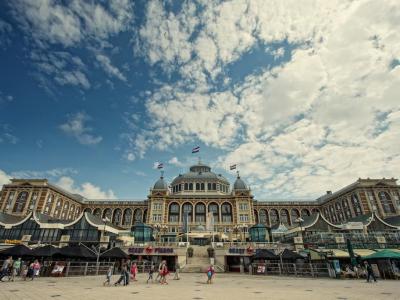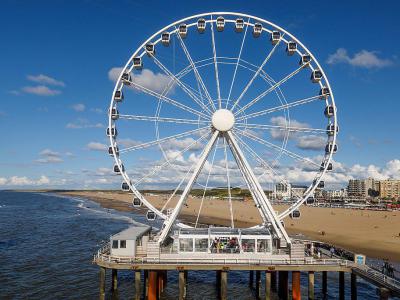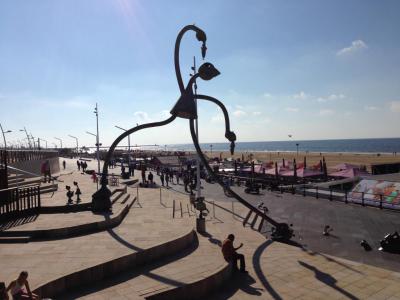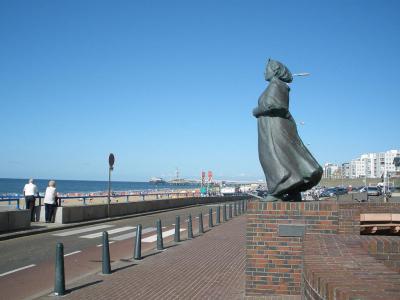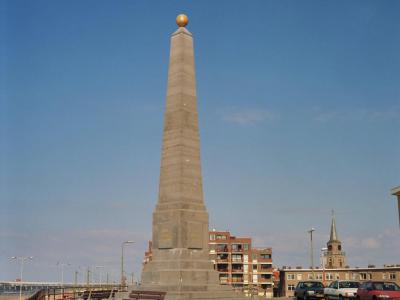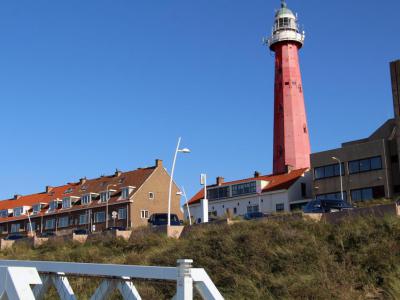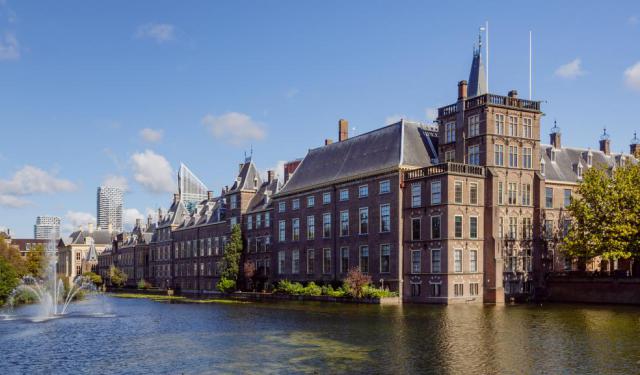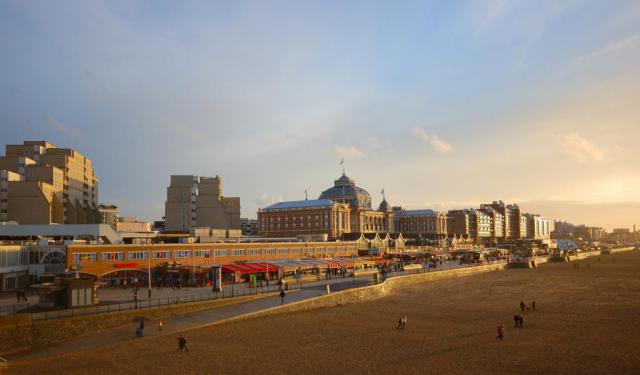
Scheveningen Walking Tour (Self Guided), Hague
Originally an independent fishing village, today Scheveningen is one of The Hague's eight districts. With its long beaches loved by both the young and old in all seasons, Scheveningen gets particularly crowded in summer.
Modern as it is, this seaside resort, the most popular in Holland, boasts a great deal of history – stretching all the way back to 1280 – with the locals still maintaining a strong sense of cultural and even linguistic identity.
The start of Scheveningen as a bathing resort dates from 1818, marked by the construction of a wooden building on a shore dune. Since then, the place has attracted numerous tourists from Europe, in addition to the many Dutch artists who had come here for centuries to paint boats and fishermen at work in the North Sea.
Another boost to Scheveningen's popularity came in 1886 with the opening of The Kurhaus hotel – thenceforth frequented by many dignitaries, including royals, and remaining one of the most exclusive hotels in the Netherlands for almost 100 years.
Walking along the esplanade, right next to the Kurhaus, you will find an iconic pleasure sight – the Scheveningen Pier. Jutting far into the North Sea from the boulevard, this gigantic pier is one of the world's top nine piers, and is particularly favored by bungee jumpers and zipline daredevils. Fully renovated in 2015, it hosts a range of shops, bars and restaurants, not to mention the 50-meter high Ferris wheel.
Another – silent – sensation in touristic Scheveningen is the Museum beelden aan Zee, a unique sculpture park built around an old pavilion, erected in 1826 by King William.
For a closer acquaintance with these and other delights of Scheveningen, consider taking our self-guided walking tour and enjoy yourself!
Modern as it is, this seaside resort, the most popular in Holland, boasts a great deal of history – stretching all the way back to 1280 – with the locals still maintaining a strong sense of cultural and even linguistic identity.
The start of Scheveningen as a bathing resort dates from 1818, marked by the construction of a wooden building on a shore dune. Since then, the place has attracted numerous tourists from Europe, in addition to the many Dutch artists who had come here for centuries to paint boats and fishermen at work in the North Sea.
Another boost to Scheveningen's popularity came in 1886 with the opening of The Kurhaus hotel – thenceforth frequented by many dignitaries, including royals, and remaining one of the most exclusive hotels in the Netherlands for almost 100 years.
Walking along the esplanade, right next to the Kurhaus, you will find an iconic pleasure sight – the Scheveningen Pier. Jutting far into the North Sea from the boulevard, this gigantic pier is one of the world's top nine piers, and is particularly favored by bungee jumpers and zipline daredevils. Fully renovated in 2015, it hosts a range of shops, bars and restaurants, not to mention the 50-meter high Ferris wheel.
Another – silent – sensation in touristic Scheveningen is the Museum beelden aan Zee, a unique sculpture park built around an old pavilion, erected in 1826 by King William.
For a closer acquaintance with these and other delights of Scheveningen, consider taking our self-guided walking tour and enjoy yourself!
How it works: Download the app "GPSmyCity: Walks in 1K+ Cities" from Apple App Store or Google Play Store to your mobile phone or tablet. The app turns your mobile device into a personal tour guide and its built-in GPS navigation functions guide you from one tour stop to next. The app works offline, so no data plan is needed when traveling abroad.
Scheveningen Walking Tour Map
Guide Name: Scheveningen Walking Tour
Guide Location: Netherlands » Hague (See other walking tours in Hague)
Guide Type: Self-guided Walking Tour (Sightseeing)
# of Attractions: 7
Tour Duration: 1 Hour(s)
Travel Distance: 2.7 Km or 1.7 Miles
Author: valery
Sight(s) Featured in This Guide:
Guide Location: Netherlands » Hague (See other walking tours in Hague)
Guide Type: Self-guided Walking Tour (Sightseeing)
# of Attractions: 7
Tour Duration: 1 Hour(s)
Travel Distance: 2.7 Km or 1.7 Miles
Author: valery
Sight(s) Featured in This Guide:
- Kurhaus of Scheveningen
- Scheveningen Pier
- Beelden aan Zee (Sculptures by the Sea) Museum
- Scheveningen Promenade and Beach
- Fisherman's wife of Scheveningen
- Gedenknaald Koning Willem I (Memorial of King William I)
- Scheveningen Lighthouse
1) Kurhaus of Scheveningen
The Kurhaus of Scheveningen is a historic hotel located in the main beachfront area of Scheveningen, a popular seaside resort. This grand building is considered an iconic landmark in Scheveningen.
Constructed between 1884 and 1885 by the German architects Johann Friedrich Henkenhaf and Friedrich Ebert, the Kurhaus originally included a concert hall and a hotel featuring 120 rooms. Unfortunately, it suffered significant damage from a fire and had to undergo reconstruction between 1886 and 1887. The exquisite ceilings were adorned with paintings created by the Brussels artist Van Hoeck and his extensive workshop. During its prime, the Kurhaus hosted numerous kings and heads of state.
On August 8, 1964, the legendary band The Rolling Stones held a concert at the Kurhaus, but they had to hastily exit the venue due to the overwhelming number of enthusiastic fans outside. Another notable performance occurred on February 11, 1971, when Ike & Tina Turner graced the stage at the Kurhaus. This performance was broadcast on Dutch television and later released on DVD in 2004 under the title "The Legends Ike & Tina Turner Live in '71."
After a comprehensive renovation, the Kurhaus was officially reopened in 1979, with the presence of Princess Beatrix marking this significant event.
Constructed between 1884 and 1885 by the German architects Johann Friedrich Henkenhaf and Friedrich Ebert, the Kurhaus originally included a concert hall and a hotel featuring 120 rooms. Unfortunately, it suffered significant damage from a fire and had to undergo reconstruction between 1886 and 1887. The exquisite ceilings were adorned with paintings created by the Brussels artist Van Hoeck and his extensive workshop. During its prime, the Kurhaus hosted numerous kings and heads of state.
On August 8, 1964, the legendary band The Rolling Stones held a concert at the Kurhaus, but they had to hastily exit the venue due to the overwhelming number of enthusiastic fans outside. Another notable performance occurred on February 11, 1971, when Ike & Tina Turner graced the stage at the Kurhaus. This performance was broadcast on Dutch television and later released on DVD in 2004 under the title "The Legends Ike & Tina Turner Live in '71."
After a comprehensive renovation, the Kurhaus was officially reopened in 1979, with the presence of Princess Beatrix marking this significant event.
2) Scheveningen Pier (must see)
The Scheveningen Pier is for pleasure. It opened in 1959, replacing the ruins of the earlier pier which was destroyed in World War II. The first Sheveningen Pier, named Stroll Main Queen Wilhelmina opened in 1901. It was a wooden structure built on a steel foundation directly in front of the Kurhaus hotel.
In September 1959 the current pier opened. It construction was unusual. It was in two levels, an upper and lower deck. The upper deck was exposed to the weather and the lower level was closed to the elements. There were four terminals called "islands".
In 2014 the Kondor Wessels Group bought the pier and they had plans. In 2015 the upper deck was reopened and provided with a restaurant and a Bungee jumping station. The pier has a tall tower rising over the waters of Scheveningen. One may climb to the top, but be advised it is a climb. Three hundred steps up and the same three hundred down.
If the tower is not thrilling enough, may we recommend the Ferris Wheel? Yes, the first Dutch Giant Ferris Wheel, offering spectacular views of the sea and the Hague skyline. The wheel has 36 closed cars with air conditioning and one car with a glass floor for those daring souls who like to look down. Not risky enough? Try the Casino.
In September 1959 the current pier opened. It construction was unusual. It was in two levels, an upper and lower deck. The upper deck was exposed to the weather and the lower level was closed to the elements. There were four terminals called "islands".
In 2014 the Kondor Wessels Group bought the pier and they had plans. In 2015 the upper deck was reopened and provided with a restaurant and a Bungee jumping station. The pier has a tall tower rising over the waters of Scheveningen. One may climb to the top, but be advised it is a climb. Three hundred steps up and the same three hundred down.
If the tower is not thrilling enough, may we recommend the Ferris Wheel? Yes, the first Dutch Giant Ferris Wheel, offering spectacular views of the sea and the Hague skyline. The wheel has 36 closed cars with air conditioning and one car with a glass floor for those daring souls who like to look down. Not risky enough? Try the Casino.
3) Beelden aan Zee (Sculptures by the Sea) Museum (must see)
The Sculptures by the Sea Museum (Beelden aan Zee Museum) is located in the Scheveningen district of The Hague. It was established in 1994 by the art collectors Theo and Lida Scholten. Notably, it is the only museum in the Netherlands dedicated exclusively to showcasing sculpture.
This museum is known for its display of contemporary sculptures, both from international and national artists. The curators regularly organize new exhibitions, typically three or more times a year, in its spacious circular main hall. These exhibitions revolve around various themes, such as the 2010 "Unwanted Land" exhibition featuring works by six contemporary artists or the "Fathers and Sons" show, which explores the relationship between artists and their offspring. Additionally, the museum often highlights the works of individual artists like Karel Appel, Wim Quist, Man Ray, and Fritz Koenig. The museum's mission is to showcase the diverse aspects of human experience through art.
The architectural design of the museum building is noteworthy, created by architect Wim Quist. It is situated beneath the historical "Pavilion of Wied," constructed in 1826 by King William I for his wife, Princess Wilhelmine of Prussia. Before the construction began, the municipality of The Hague stipulated that the museum should not be visible from the nearby dunes. Consequently, the museum was constructed entirely underground, with terraces on the dune that are also hidden from a distance. The museum is similarly not visible from the boulevard. While visitors can enjoy a sea view from the museum's rooftop, the boulevard and Scheveningen beach remain out of sight.
Due to its concealed location, the museum can be somewhat challenging to locate, although there are signposts at the end of the street directing visitors. The museum building, made predominantly of concrete and glass, features a unique slot-system in its concrete walls, designed by the architect. This system allows for the hanging of sculptures or paintings from bolts embedded in the walls. The museum is designed with multiple levels, with natural light filtering in from above in various spaces. It includes outdoor areas and provides raincoats for visitors. Furthermore, there is a cafe, a bookshop, and facilities to accommodate visitors with disabilities.
This museum is known for its display of contemporary sculptures, both from international and national artists. The curators regularly organize new exhibitions, typically three or more times a year, in its spacious circular main hall. These exhibitions revolve around various themes, such as the 2010 "Unwanted Land" exhibition featuring works by six contemporary artists or the "Fathers and Sons" show, which explores the relationship between artists and their offspring. Additionally, the museum often highlights the works of individual artists like Karel Appel, Wim Quist, Man Ray, and Fritz Koenig. The museum's mission is to showcase the diverse aspects of human experience through art.
The architectural design of the museum building is noteworthy, created by architect Wim Quist. It is situated beneath the historical "Pavilion of Wied," constructed in 1826 by King William I for his wife, Princess Wilhelmine of Prussia. Before the construction began, the municipality of The Hague stipulated that the museum should not be visible from the nearby dunes. Consequently, the museum was constructed entirely underground, with terraces on the dune that are also hidden from a distance. The museum is similarly not visible from the boulevard. While visitors can enjoy a sea view from the museum's rooftop, the boulevard and Scheveningen beach remain out of sight.
Due to its concealed location, the museum can be somewhat challenging to locate, although there are signposts at the end of the street directing visitors. The museum building, made predominantly of concrete and glass, features a unique slot-system in its concrete walls, designed by the architect. This system allows for the hanging of sculptures or paintings from bolts embedded in the walls. The museum is designed with multiple levels, with natural light filtering in from above in various spaces. It includes outdoor areas and provides raincoats for visitors. Furthermore, there is a cafe, a bookshop, and facilities to accommodate visitors with disabilities.
4) Scheveningen Promenade and Beach
Scheveningen, a long time ago a small fishing village, today is one of the most famous and popular beaches in the Netherlands. The beach is about 14.6 miles long and near 350 yards wide. It is on the North Sea. It reaches from the West Dune Park in the southwest to the East Dune Park in the northeast. On sunny summer days it can get very crowded.
The beaches have won several awards for cleanliness of the beach and quality of water. In 2021 It was awarded the international "Blue Flag" for the 11th time. There are four informal sections to the beach. Zwarte Pad (Black Path), Noorderstrand (North Beach), Zuiderstrand (South Beach), and Kijkduin.
The Promenade at Scheveningen stretches 2.5 miles. Beside the pleasant sandy beach one may encounter innumerable diversions. There are the colorful Esplanade, the Scheveningen Pier and lighthouse, a Sea Life aquarium, Path cinema, Kurhaus Music Theater, the Scheveningen Museum and a casino. Cubs, restaurants, and surf schools line the boulevard.
The beaches have won several awards for cleanliness of the beach and quality of water. In 2021 It was awarded the international "Blue Flag" for the 11th time. There are four informal sections to the beach. Zwarte Pad (Black Path), Noorderstrand (North Beach), Zuiderstrand (South Beach), and Kijkduin.
The Promenade at Scheveningen stretches 2.5 miles. Beside the pleasant sandy beach one may encounter innumerable diversions. There are the colorful Esplanade, the Scheveningen Pier and lighthouse, a Sea Life aquarium, Path cinema, Kurhaus Music Theater, the Scheveningen Museum and a casino. Cubs, restaurants, and surf schools line the boulevard.
5) Fisherman's wife of Scheveningen
Near Scheveningen Boulevard, there stands a fishermen's monument that was revealed once again in 1982. This monument takes the form of a statue portraying a fisherwoman from Scheveningen dressed in traditional attire. You can find it at the intersection of Keizerstraat and what is now known as Kalhuisplaats. The significance of the woman's gaze lies in its unwavering focus on the sea, where she once hoped to see one or more of her loved ones - whether it be her suitor, husband, son, or father.
The sculptor and goldsmith Gerard Bakker crafted this statue, and it was officially unveiled on November 10, 1982, by Queen Beatrix at that time. An annual remembrance ceremony has been held for several years, commencing at the local Old Church and culminating at the statue. During this event, Inge Lievaart's poem inscribed on the pedestal is recited, followed by the laying of wreaths and a tribute of flowers. The poem reads as follows:
The Sea, Which Always Take Again
Will Return Once
All Who Stayed
To Him Who Escape First
The Lord Of Wind And Water
To Christ Triumphator.
The sculptor and goldsmith Gerard Bakker crafted this statue, and it was officially unveiled on November 10, 1982, by Queen Beatrix at that time. An annual remembrance ceremony has been held for several years, commencing at the local Old Church and culminating at the statue. During this event, Inge Lievaart's poem inscribed on the pedestal is recited, followed by the laying of wreaths and a tribute of flowers. The poem reads as follows:
The Sea, Which Always Take Again
Will Return Once
All Who Stayed
To Him Who Escape First
The Lord Of Wind And Water
To Christ Triumphator.
6) Gedenknaald Koning Willem I (Memorial of King William I)
The Memorial of King William I is a monument that serves as a tribute to two significant events in Dutch history. It commemorates Prince William V's, the last hereditary stadtholder of the Republic of the United Netherlands, departure in 1795 and the arrival of William I Frederik, the first king of the Netherlands, in Scheveningen on November 30, 1813.
The idea to construct this monument originated in 1863 under the initiative of King Willem III. He appointed his uncle, Prince Frederik, as the chairman of a committee tasked with creating a national memorial that would honor the restoration of Dutch independence.
On August 24, 1865, which coincided with King Willem I's birthday, the commemorative monument, in the form of a needle-like structure, was unveiled. Prince Frederik delivered a speech during the ceremony, and Mr. H. Baron Collot d'Escury, who was acting as the mayor at the time, officially received the monument on behalf of the municipality. Notable attendees at the event included Queen Sophia, Crown Prince William, Prince Alexander, and Prince Hendrik.
This monument holds national significance and was designed by architect Arend Roodenburg, with construction carried out by stonemasons PJ Devillers & Company. In 2003, the monument underwent restoration to preserve its historical importance.
In 1863, as a tribute to the aforementioned events, William III laid the foundation stone for Plein 1813, which was subsequently unveiled six years later by Prince Frederik.
The idea to construct this monument originated in 1863 under the initiative of King Willem III. He appointed his uncle, Prince Frederik, as the chairman of a committee tasked with creating a national memorial that would honor the restoration of Dutch independence.
On August 24, 1865, which coincided with King Willem I's birthday, the commemorative monument, in the form of a needle-like structure, was unveiled. Prince Frederik delivered a speech during the ceremony, and Mr. H. Baron Collot d'Escury, who was acting as the mayor at the time, officially received the monument on behalf of the municipality. Notable attendees at the event included Queen Sophia, Crown Prince William, Prince Alexander, and Prince Hendrik.
This monument holds national significance and was designed by architect Arend Roodenburg, with construction carried out by stonemasons PJ Devillers & Company. In 2003, the monument underwent restoration to preserve its historical importance.
In 1863, as a tribute to the aforementioned events, William III laid the foundation stone for Plein 1813, which was subsequently unveiled six years later by Prince Frederik.
7) Scheveningen Lighthouse
The Scheveningen Lighthouse is a prominent maritime beacon with a rich history dating back to the 16th century. Initially, Scheveningen had an early form of a lighthouse, supported financially by church-collected ship fees. Significant enhancements occurred in 1850, including the addition of a copper cupola and a new lighting system.
The current lighthouse, as we know it today, was completed in 1875. It was the brainchild of Quirinus Harder, a renowned Dutch lighthouse designer of the era. Harder's design is notable for its utilization of cast iron, a material choice that was innovative for the time. The structure comprises nine segments, showcasing the architectural and engineering prowess of the 19th century.
At the base of the lighthouse tower, there are several key facilities. These include a house for the supervisor and four additional dwellings for the lighthouse keeper and their staff. This arrangement underscores the lighthouse's role as not just a navigational aid but also a home for those who maintained it.
One of the most fascinating aspects of the Scheveningen Lighthouse is its original lighting mechanism. The light, known for its rotation, operated within a mercury bath. This system, though effective for its time, was eventually replaced in the 1960s by a more modern electrical system. This upgrade marked a significant technological advancement in lighthouse operations, reflecting the evolving needs and capabilities of maritime navigation aids.
The current lighthouse, as we know it today, was completed in 1875. It was the brainchild of Quirinus Harder, a renowned Dutch lighthouse designer of the era. Harder's design is notable for its utilization of cast iron, a material choice that was innovative for the time. The structure comprises nine segments, showcasing the architectural and engineering prowess of the 19th century.
At the base of the lighthouse tower, there are several key facilities. These include a house for the supervisor and four additional dwellings for the lighthouse keeper and their staff. This arrangement underscores the lighthouse's role as not just a navigational aid but also a home for those who maintained it.
One of the most fascinating aspects of the Scheveningen Lighthouse is its original lighting mechanism. The light, known for its rotation, operated within a mercury bath. This system, though effective for its time, was eventually replaced in the 1960s by a more modern electrical system. This upgrade marked a significant technological advancement in lighthouse operations, reflecting the evolving needs and capabilities of maritime navigation aids.
Walking Tours in Hague, Netherlands
Create Your Own Walk in Hague
Creating your own self-guided walk in Hague is easy and fun. Choose the city attractions that you want to see and a walk route map will be created just for you. You can even set your hotel as the start point of the walk.
The Hague Introduction Walking Tour
While the official capital of the Netherlands is Amsterdam, The Hague is the country's de facto capital and administrative center.
Little is known about the origin of The Hague as such. What is certain is that it was founded by one of the last counts of the House of Holland, Floris IV, who already owned two residences in the area, but had his eye set on a waterfront property near the pond... view more
Tour Duration: 2 Hour(s)
Travel Distance: 3.5 Km or 2.2 Miles
Little is known about the origin of The Hague as such. What is certain is that it was founded by one of the last counts of the House of Holland, Floris IV, who already owned two residences in the area, but had his eye set on a waterfront property near the pond... view more
Tour Duration: 2 Hour(s)
Travel Distance: 3.5 Km or 2.2 Miles
Hague's Classic Architectural Jewels
As the third largest metropolis in the Netherlands, The Hague has plenty to offer architecturally discerning travelers. The city is a living proof of a harmonious coexistence between a modern, easy on the eye skyline and a steeped in history downtown. Owing to its fascinating (political) past, The Hague has a plethora of historic buildings associated with worship, governance, royalty and... view more
Tour Duration: 2 Hour(s)
Travel Distance: 2.9 Km or 1.8 Miles
Tour Duration: 2 Hour(s)
Travel Distance: 2.9 Km or 1.8 Miles
The Most Popular Cities
/ view all
